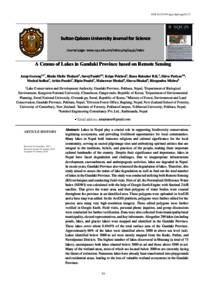وثيقة
A census of lakes in Gandaki Province based on remote sensing.
المعرف
DOI:10.53539/squjs.Splisspp10-23
المصدر
Sultan Qaboos University Journal for Science, v. 29, no. 2, p. 10-23.
المساهمون
Thakuri, Bindu Malla., مؤلف
Panthi, Saroj., مؤلف
Pokhrel, Kripa., مؤلف
Bahadur, Rana B.K., مؤلف
Pariyar, Shiva., مؤلف
Sedhai, Nischal., مؤلف
Poudel, Arbin, مؤلف
Poudel, Bipin., مؤلف
Dhakal, Maheswar., مؤلف
Dhakal, Shova., مؤلف
Mishra, Bhogendra., مؤلف
عناوين أخرى
العلمي للبحيرات في مقاطعة غانداكي بالاعتماد على الاستشعار عن بعد الحديث.
الدولة
Oman.
مكان النشر
Muscat
الناشر
College of Science, Sultan Qaboos University.
ميلادي
2024-08-16
اللغة
الأنجليزية
الملخص الإنجليزي
Lakes in Nepal play a crucial role in supporting biodiversity conservation, regulating ecosystems, and providing livelihood opportunities for local communities. Many lakes in Nepal hold immense religious and cultural significance for the local community, serving as sacred pilgrimage sites and embodying spiritual entities that are integral to the traditions, beliefs, and practices of the people, making them important cultural landmarks of the country. Despite their significance and importance, lakes in Nepal have faced degradation and challenges. Due to inappropriate infrastructure development, encroachment, and anthropogenic activities, lakes are degraded in Nepal. In recent years, Gandaki Province also witnessed the degradation of lakes. Therefore, this study aimed to assess the status of lake degradation as well as find out the total number of lakes in the Gandaki Province. The study was conducted utilizing both Remote Sensing (RS) techniques and conducting field visits. First of all, the Normalized Difference Water Index (NDWI) was calculated with the help of Google Earth Engine with Sentinal 2A/B satellite. That gives the water area, and then polygons of water bodies were created throughout the province in an identified area. These polygons were uploaded in ArcGIS and a base map was added. In the ArcGIS platform, polygons were further edited for the precise area using very high-resolution imagery. These edited polygons were further verified in Google Earth. Field visits, personal phone inquiries, and group discussions were conducted for further verification. Data were also collected from municipality/rural municipality, elected representatives, and key informants. Altogether 290 lakes (including ponds, lakes, and glacier lakes) were mapped and identified in the Gandaki Province. These lakes cover about 0.1045% of the total surface area of the Gandaki Province. Approximately 60% of the lakes were identified above 3000 m above sea level (asl). Lakes identified below 3000 m asl were mostly mapped from the Kaski, Parbat, and Nawalparasi Districts. The highest number of lakes discovered in Mustang (a total of 73 lakes), encompasses both lakes situated below 3000 m asl and those above 4500 m asl. Many of the wetland areas, most of which are located below 3000 m are currently facing the threat of extinction. Numerous lakes have already been transformed into playgrounds and residential areas, leading to the loss of valuable wetland ecosystems in the Gandaki Province. It is crucial to develop a comprehensive provincial inventory of lakes that includes detailed information divided across new political boundaries. This practice would aid in effective lake management and conservation efforts in the Gandaki Province.
ISSN
Online: 2414-536X
Print: 1027-524X
الملخص العربي
تلعب البحيرات في نيبال دورًا مهما في الحفاظ على التنوع الحيوى، وتنظيم النظم البيئية، وتوفير فرص كسب العيش للمجتمعات المحلية. تحمل العديد من البحيرات في نيبال أهمية دينية وثقافية هائلة للمجتمع المحلي، فهي بمثابة مواقع مقدسة وتجسد الكيانات الروحية التي تعد جزءًا لا يتجزأ من تقاليد ومعتقدات وممارسات المجتمع، مما يجعلها معالم ثقافية مهمة للبلاد. وعلى الرغم من أهميتها، فقد واجهت البحيرات في نيبال التدهور والتحديات، بسبب التطوير غير العقلاني للبنية التحتية، وكذلك الأنشطة البشرية. وفي السنوات الأخيرة، شهدت مقاطعة غانداكي أيضًا تدهور البحيرات. ولذلك، هدفت هذه الدراسة إلى تقييم حالة تدهور البحيرات وكذلك معرفة العدد الإجمالي للبحيرات في مقاطعة غانداكي. وأجريت الدراسة باستخدام تقنيات الاستشعار عن بعد (RS) وإجراء الزيارات الميدانية. وقد تم حساب مؤشر اختلاف المياه الطبيعي (NDWI) بمساعدة محرك جوجل ايرث باستخدام صور القمر الصناعي Sentinal 2A/B. تم إنشاء مضلعات من المسطحات المائية في جميع أنحاء المحافظة في منطقة محددة. كما تم تحميل هذه المضلعات في نظام ArcGIS وتم ايضا إضافة خريطة أساسية. في نظام ArcGIS الأساسي، تم تعديل المضلعات بشكل أكبر للمنطقة المحددة باستخدام صور عالية الدقة. كما تم التحقق من هذه المضلعات المعدلة بشكل أكبر في برنامج جوجل ايرث. كما تم إجراء زيارات ميدانية واستفسارات هاتفية شخصية ومناقشات جماعية لمزيد من التحقق. تم أيضا جمع البيانات من البلدية/البلدية الريفية والممثلين المنتخبين والمخبرين الرئيسيين. وتم رسم خرائط وتحديد 290 بحيرة (بما في ذلك البرك والبحيرات والبحيرات الجليدية) في مقاطعة غانداكي. تغطي هذه البحيرات حوالي 0.1045% من إجمالي مساحة مقاطعة غانداكي. تم تحديد حوالي 60% من البحيرات فوق ارتفاع 3000 متر فوق مستوى سطح البحر. كما تم رسم خرائط البحيرات التي تم تحديدها على عمق أقل من 3000 متر من مناطق كاسكي وباربات وناوالباراسي. وقد وجد ان أكبر عدد من البحيرات المكتشفة في موستانج (إجمالي 73 بحيرة) يشمل البحيرات التي تقع على ارتفاع أقل من 3000 متر فوق سطح البحر وتلك التي يزيد ارتفاعها عن 4500 متر فوق سطح البحر. تواجه حالياً العديد من مناطق الأراضي الرطبة، والتي يقع معظمها تحت 3000 متر خطر الانقراض. وقد تم بالفعل تحويل العديد من البحيرات إلى ملاعب ومناطق سكنية، مما أدى إلى فقدان النظم البيئية القيمة للأراضي الرطبة في مقاطعة غانداكي. ومن المهم تطوير قائمة جرد إقليمية شاملة للبحيرات تتضمن معلومات مفصلة مقسمة عبر الحدود السياسية الجديدة. من شأن هذه الممارسة أن تساعد في الإدارة الفعالة للبحيرات وجهود الحفاظ عليها في مقاطعة غانداكي.
قالب العنصر
مقالات الدوريات

